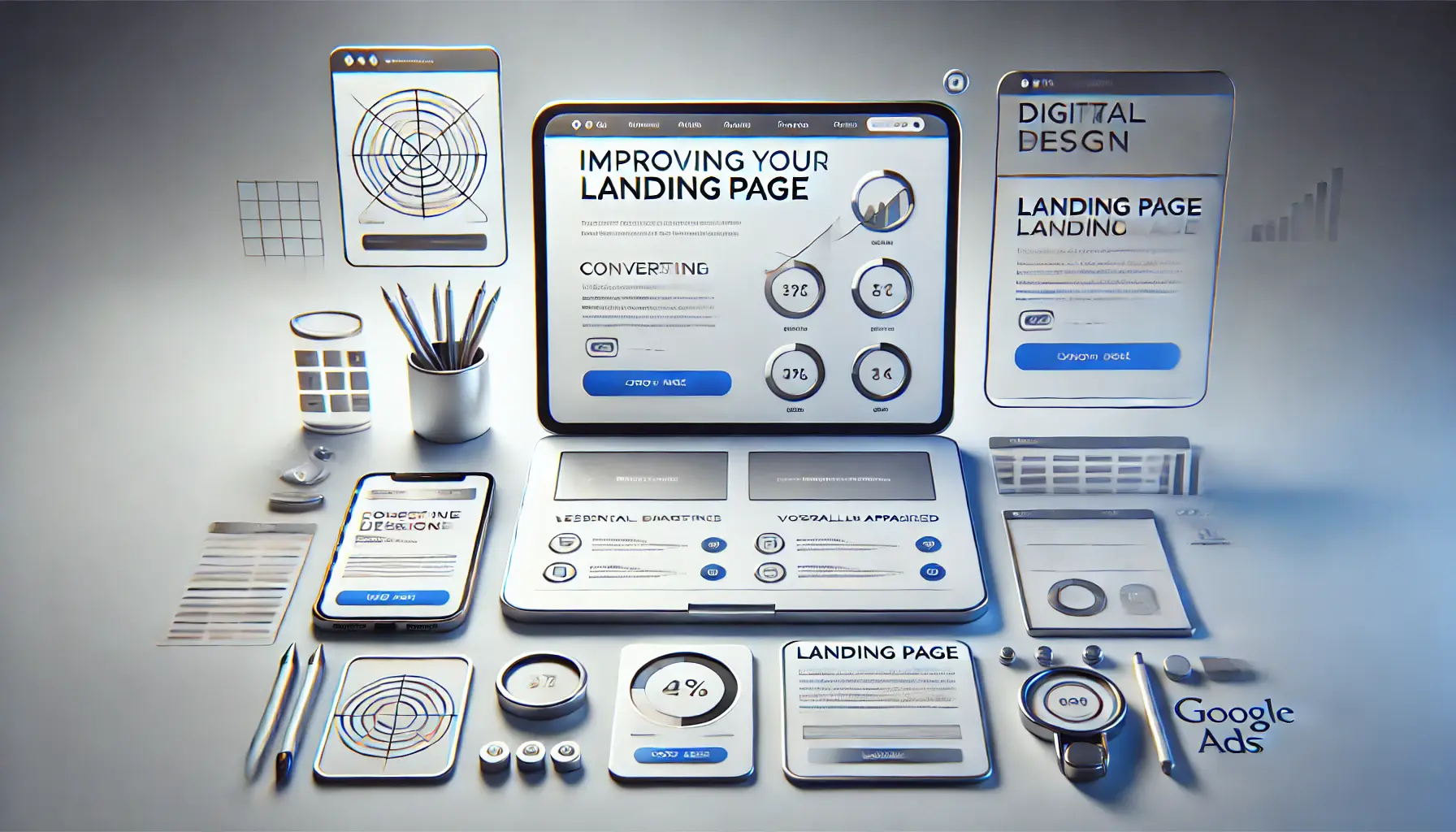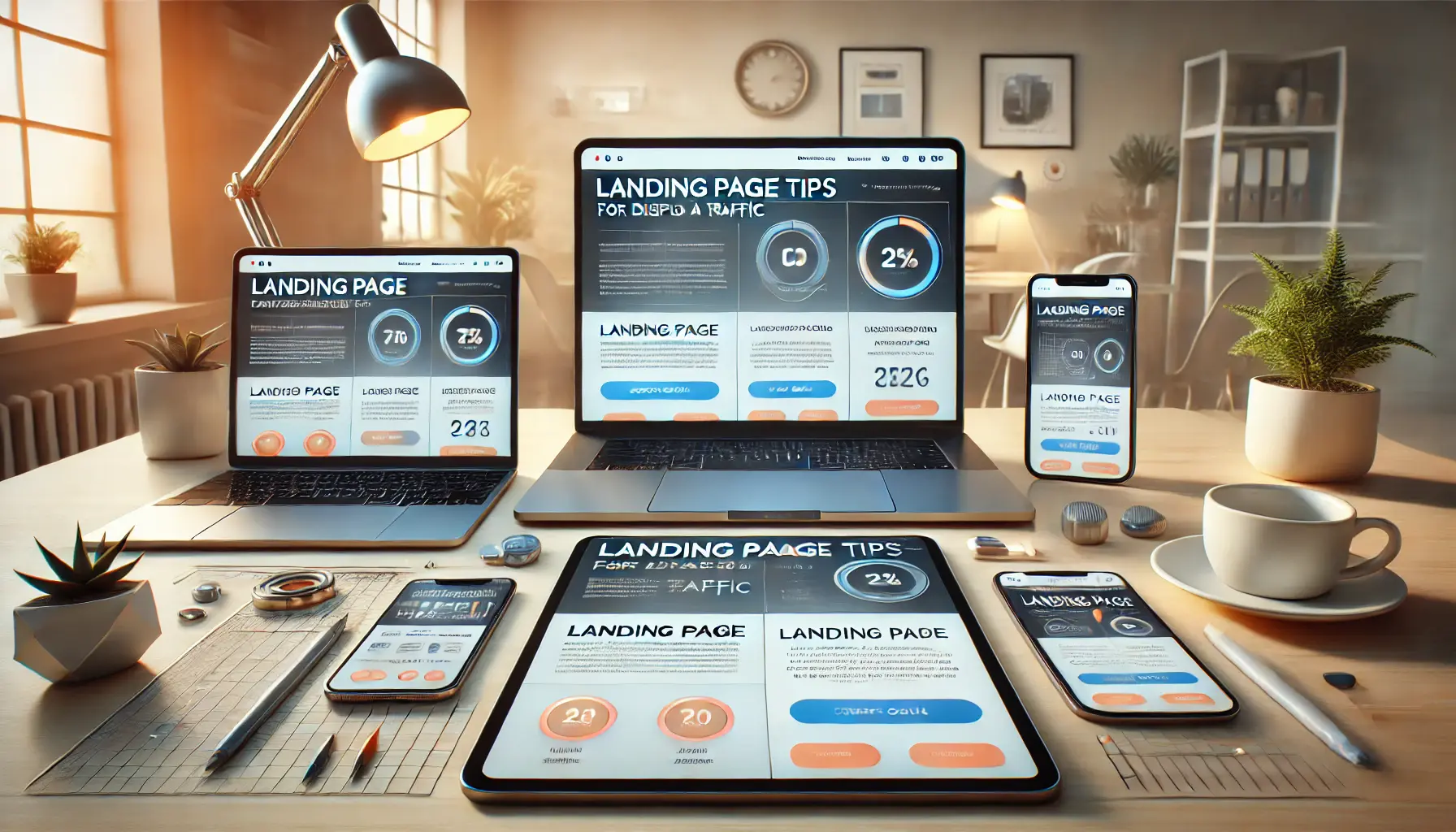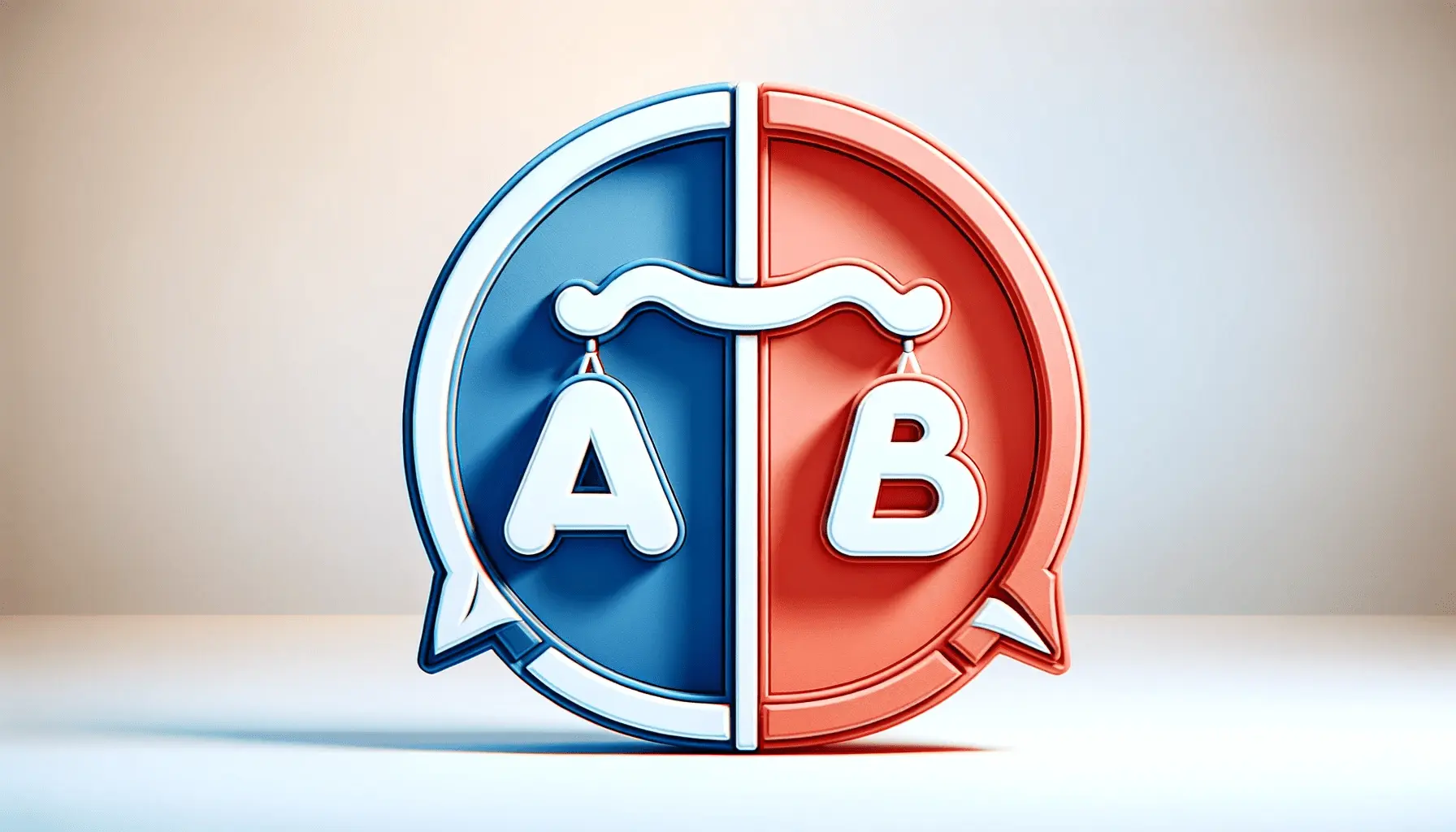In the real lion’s den of Google Ads, one thing differentiates a good campaign from an average one: coherenceThe logical connection or consistency between parts. between ad copy and landing page.
This harmony is extremely important in ensuring that users do not just click on your ad but also follow through to the landing page with the desired action.
Without this, there is the possibility that prospective customers could be lost since they may become confused, disappointed, or even frustrated between what was expected and what is there.
Writing ad copy that directly reflects the content and goals of a landing page really accomplishes the engaging of a user experience, encouragement of conversions, and building trust in your audience.
In this article, we will discuss the main aspects of matching your ad copy and landing page to enhance the effectiveness of your Google Ads campaign.
We’ll cover the importance of consistency, the step-by-step creation of a perfect match between your ads and landing pages, and how to track and optimize your efforts.
Let’s dive in!
- The Importance of Ad Copy and Landing Page Consistency
- How to Optimize Landing Pages for Better Ad Performance
- Common Ad Copy and Landing Page Alignment Mistakes
- Tracking and Analyzing Results to Improve Synergy of the Ad and Landing Page
- How to Maximize Ad Copy and Landing Page Synergy for Best Results
- Ad Copy and Landing Page Synergy Questions
The Importance of Ad Copy and Landing Page Consistency
Consistency between your ad copy and landing page is extremely important for user trust and conversions.
Whenever a potential customer clicks on an ad, they want to get exactly what it promised.
Any inconsistency—whether in tone, content, or offer—may confuse them, leading to a fall in trust and an increase in bounce ratesThe percentage of visitors who leave a webpage without taking any action..
Keeping your messaging clear and aligned is key in this regard.
Why does consistency matter?
Think about it: Would you trust a brand that promised you one thing in their ad, only to deliver something completely different on their landing page?
Probably not.
Consistency represents reliability and professionalism, and it gives potential customers a greater inclination toward taking them through the journey from ad click to conversion.

An image representing the importance of consistency between ad and landing page for conversions.
Why Consistency Matters for Conversions
When your ad copy and landing page represent harmony, users feel reassured that they are in the right place.
Continuity builds trust, which is critical for conversion.
If a user clicks on an advertisement offering 20% off but lands on a page that makes no mention of it, they might quickly feel misled and leave the site altogether.
Consistency increases the likelihood of users taking action because they don’t have to second-guess the information.
When users feel that the ad and landing page are part of a cohesive message, they’re more comfortable moving forward.

An image showcasing how brand trust is built through consistency in user experience from ad to landing page.
User Expectations and Brand Trust
Your ad sets the expectation for what users will find when they click through.
If the landing page fails to meet these expectations, it can damage your brand’s reputation.
For instance, if an ad mentions a specific feature or product, that should be the first thing users see on the landing page.
Building the trust of your audience helps in the long run.
A seamless experience from the time they view your ad to the time they take action builds trust.
Eventually, reliability will become associated with your brand, driving customer retention and recommendations.
One of the biggest benefits of making sure the ad copy and landing page match up is the reduction of bounce rates.
When visitors get what they expect, they have less reason to leave the page without converting.
A disconnect between the ad and landing page usually results in higher bounce rates.
Relevant, targeted content that aligns with the search intent keeps users engaged and makes them more likely to complete the desired action, whether it’s making a purchase, filling out a form, or signing up for a newsletter.
Writing Ad Copy to Match Your Landing Page is an art of both creativity and strategy.
The ad copy should be the promise, while the landing page should deliver on that promise to the users for a smooth journey through both.
To create a strong match between the two, you need to ensure that the messaging, tone, and content are consistent throughout.

An image representing the strategic use of keywords in online advertising and digital marketing.
Using Keywords Effectively
One of the most crucial elements in crafting ad copy is the effective use of keywords.
Keywords not only help target the right audience but also ensure relevance between the ad and landing page.
When the keywords used in the ad are reflected on the landing page, it reassures users they have come to the right place.
- Match ad keywords with landing page content: The main keywords of your ad should be reflected in your landing page headers, body text, and even in the buttons that perform the call-to-action. This alignment enhances the relevance score in Google Ads and gives users more confidence.
- Use long-tail keywords: These are specific, targeted phrases that help personalize the ad copy. Matching long-tail keywords in the ad copy with those on the landing page improves ad performance by targeting niche audiences.

An image representing the importance of aligning value propositions between an ad and a landing page for clarity and conversions.
Aligning Value Propositions
Your value proposition should be consistent both in your ad copy and landing page to maintain trust.
If your ad mentions a discount, promotion, or unique selling point (USP), then the landing page should reinforce the same offer in a visible way.
- Offers should be visible and bold: The headline and subheadings on your landing page must support the offer or benefit so that users immediately recognize that it is related to the ad they clicked.
- Target the customer’s pain points: Both the ad copy and landing page should focus on the problems your audience faces and how your product or service provides the solution.

An image representing the importance of maintaining consistent tone and messaging across digital campaigns.
Maintaining Consistent Tone and Messaging
The tone of your ad copy sets the user experience.
This tone can be casual, professional, or urgent, but it has to reflect on the landing page for a smooth and familiar transition.
A sudden shift in tone will create confusion and diminish user trust.
- Consistent tone: If your ad copy is conversational in tone, make sure the same tone flows through the landing page. Similarly, if your ad is authoritative or urgent, your landing page should convey the same feeling of immediacy or authority.
- Call-to-Action (CTA): The CTAs in both your ad and landing page should follow a similar structure and phrasing. For example, if your ad offers a ‘Get 20% Off Now!’ CTA, then your landing page should have a similar button that says, ‘Claim Your 20% Off Now!’ This consistency encourages users to take action.
Ensuring consistency between ad copy and landing page increases user trust and boosts conversions.

An image representing key optimization elements of landing pages to improve ad performance.
How to Optimize Landing Pages for Better Ad Performance
Your landing page is that precarious pivot point where users decide to take action or leave.
Optimizing your landing page goes a long way toward improving ad performance and increasing conversion rates.
A well-optimized landing page not only aligns with your ad copy but also enhances the overall user experience, leading to better engagement and conversions.
In this section, we touch on some essential areas you should consider optimizing on your landing page to enhance ad performance.

An image representing the importance of optimizing landing pages for mobile responsiveness.
Optimization for Mobile Responsiveness
With the growth in users accessing websites through mobile devices, ensuring that your landing page is mobile-friendly has become a necessity.
A landing page that is not optimized for mobile can lead to a poor user experience, causing users to leave without converting.
- Responsive design: Ensure that your landing page automatically adjusts to the screen size for a seamless experience across desktops, tablets, and smartphones.
- Simplified navigation: Mobile users prefer a straightforward experience. Limit the steps users must take to complete an action, such as filling out a form or making a purchase.
- Fast loading times: Page speed is critical for mobile users. Slow-loading pages lead to higher bounce rates. Optimize images, reduce scripts, and use caching to improve loading times.

An image representing the importance of clear and compelling calls to action in digital marketing.
Clear and Compelling Calls to Action
The call to action (CTA) is one of the most important elements of your landing page—it guides users through the desired action, whether it’s buying a product, signing up for a newsletter, or downloading a resource.
To be effective, your CTAs must be clear, visible, and compelling.
- Make your CTA buttons stand out: Use contrasting colors and bold text to ensure that the CTA button is easily visible. Placement is key—position the CTA where users can find it without scrolling.
- Use action-oriented language: Words like ‘Get Started,’ ‘Claim Your Discount,’ or ‘Download Now’ encourage users to take immediate action. Avoid generic CTAs such as ‘Click Here’ or ‘Learn More.’
- Keep it simple: Too many CTAs on one landing page can overwhelm users. A singular, focused CTA reduces friction, increasing conversion rates.

An image representing the importance of clear and compelling calls to action in digital marketing.
Page Load Speed and User Experience
Page load speed directly impacts user experience and, ultimately, conversion rates.
If a landing page takes too long to load, users are more likely to leave without taking any action.
Google also considers page load speed a ranking factor, so optimizing for speed can improve both your ad performance and SEO.
- Optimize images: Use image compression tools to reduce file sizes without compromising quality.
- Minimize scripts and CSS files: Too many scripts or large CSS files can slow down page rendering. Remove unnecessary code and combine files to streamline the loading process.
- Use browser caching: Caching stores a copy of your landing page on the user’s device, allowing faster load times on subsequent visits.
Optimizing your landing pages can improve user experience, enhance engagement, and drive conversions from your ads.

An image representing common mistakes in aligning ad copy with landing pages in digital marketing.
Common Ad Copy and Landing Page Alignment Mistakes
Even the most finely tuned ad campaigns can fall flat when the alignment between your ad copy and your landing page is off-kilter.
Neglecting proper integration of these two components can confuse users, degrade trust, and ultimately hurt conversion rates.
In this section, we will discuss some common mistakes businesses make when trying to align their ad copy with their landing pages and offer tips on how to avoid them.
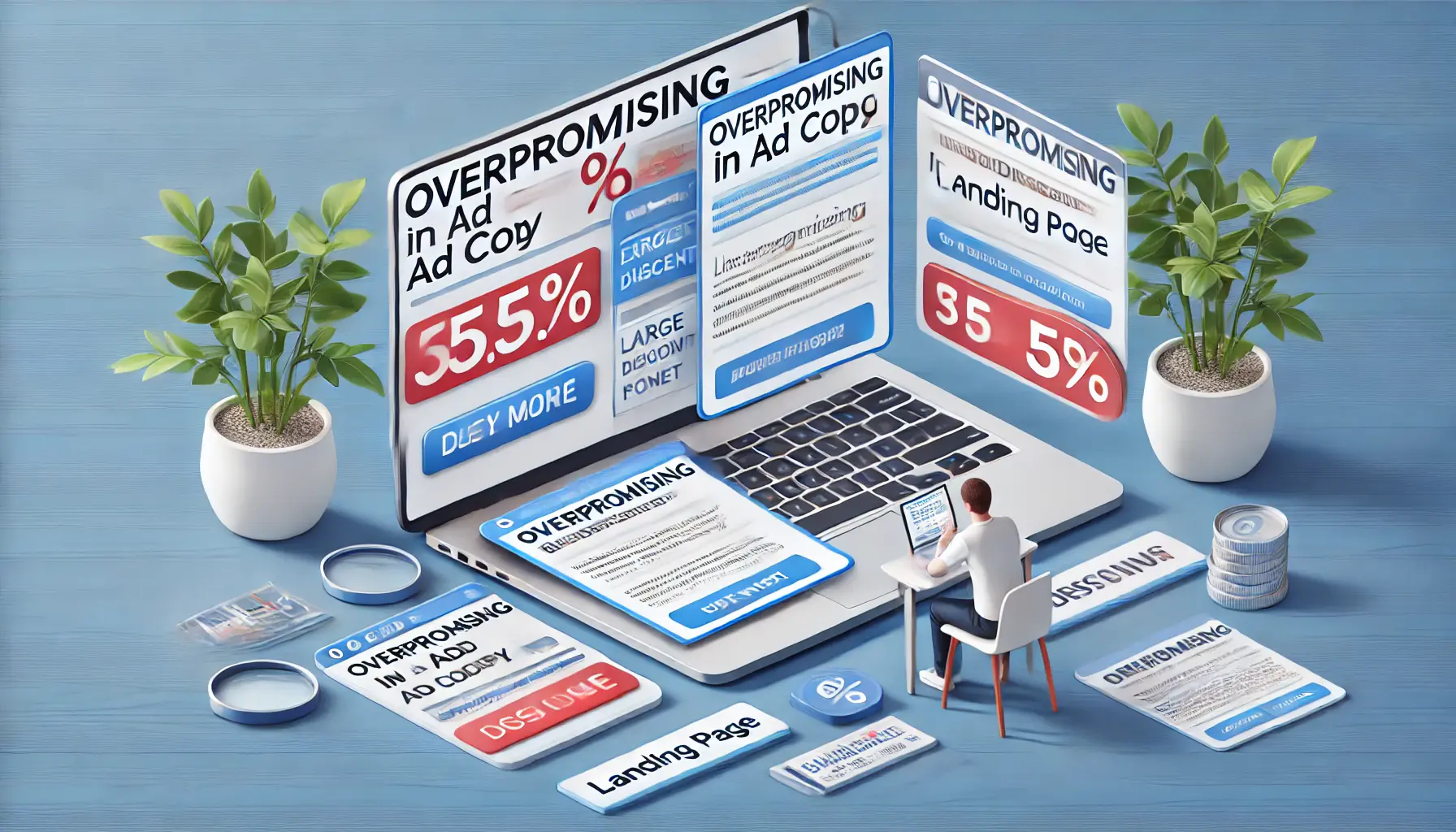
An image representing the risks of overpromising in ad copy, leading to disappointment on the landing page.
Overpromising in Ad Copy
One of the most common errors in ad copy is over-inflating what your landing page or product will deliver.
This creates a discrepancy between what users expect and what they get when they click the ad.
If users land on a page that fails to meet the expectations set by the ad, they are likely to leave the site, resulting in higher bounce rates and diminished trust.
- Solution: Ensure your ad copy is honest and realistic. If your ad highlights a specific benefit or discount, make sure this information is clearly presented on your landing page.

An image representing the problem of inconsistent design and layout between ad copy and landing pages in digital marketing.
Inconsistent Design and Layout
Another common pitfall is an inconsistency in design and layout between the ad and the landing page.
If the landing page uses a completely different style, color scheme, or branding from the ad, it presents users with a disjointed experience and may lead them to question whether they landed on the correct page.
- Solution: Ensure the design of your landing page reflects the look and feel of your ad. This includes using consistent fonts, colors, and images. The user experience should feel seamless from the ad to the landing page.

An image representing the importance of A/B testing in digital marketing to compare different versions of landing pages or ads.
Neglecting A/B Testing
Many businesses overlook the importance of A/B testingA method of comparing two versions of a webpage or ad to determine which performs better. when it comes to optimizing ad copy and landing page alignment.
A/B testing involves comparing two versions of your ad or landing page to determine which performs better.
Without testing, you’re simply guessing what your target audience will respond to, potentially missing opportunities for improvement.
- Solution: Run regular A/B tests on both your ad copy and landing pages to determine what works best together. Test different headlines, images, CTAs, and designs to find the optimal combination for driving conversions.

An image representing the consequences of ignoring the user journey in digital marketing campaigns.
Ignoring the User Journey
It’s easy to focus solely on the ad copy and landing page without considering the broader user journey.
If the landing page does not make sense within the context of your customer’s journey—from seeing the ad to completing the desired action—users may drop off midway, feeling lost or unmotivated.
- Solution: Take a holistic approach by mapping out the user journey from the ad to the landing page and beyond. Ensure that each step is clear, connected, and encourages users to move forward.
Overpromising in ad copy or having inconsistent design can damage trust and increase bounce rates.
An image representing the importance of tracking and analyzing data to improve the synergy between ad and landing page.
Tracking and Analyzing Results to Improve Synergy of the Ad and Landing Page
While creating synergy between your ad copy and landing page is crucial, long-term success depends on your ability to track and analyze the performance of both.
Measuring key performance indicators (KPIs) shows what is working and where adjustments should be made to improve conversion rates.
In this section, we will go through how to track and report on your performance to optimize ad copy and landing page alignment.
An image representing the process of setting up conversion tracking to measure user actions and optimize digital campaigns.
Setting Up Conversion Tracking
One of the most crucial steps in tracking ad performance is setting up conversion trackingA method used to track the actions users take after clicking on an ad, such as purchasing or signing up..
Conversion tracking measures the actions people take after clicking your ad, such as purchasing something, filling out a form, or signing up for your newsletter.
This will give you a realistic view of how well your ad copy and landing page are working together to drive the desired outcomes of your campaigns.
- Google Ads Conversion Tracking: Set up Google Ads conversion tracking by adding a small piece of code called a tracking tag to your landing page. This code tracks user actions after clicking your ad, helping you measure conversion rates and understand user behavior on your landing page.
- Analytics Tools: Use analytics platforms such as Google Analytics to gain deeper insights into user behavior, including bounce rates, time spent on the page, and specific actions taken. These insights allow you to identify areas for improvement and make data-driven decisions to increase conversions.

An image representing the importance of analyzing user behavior to optimize the user experience in digital marketing.
Analyzing User Behavior
Analyzing user behavior is crucial for optimizing your landing page.
By tracking how users interact with your landing page, you can prioritize improvements and make adjustments that drive better results.
- Heatmaps: Leverage heatmaps to understand which elements users click, scroll, or spend the most time on. This data helps you identify which parts of your landing page are capturing attention and which might be overlooked.
- Session Recordings: Tools like Hotjar and Crazy Egg offer session recordings that allow you to watch users’ interactions in real-time. This can help identify usability issues or moments when users lose interest.
- Bounce Rates and Exit Pages: High bounce rates or frequent exits from certain pages indicate a disconnect between the ad and landing page content. Analyze these metrics to determine which elements need adjustment.

An image representing the process of iterating based on performance data to optimize digital marketing campaigns.
Iterating Based on Performance Data
With performance data in hand, it’s time to act on the insights to improve results.
Testing and iteration should be continuous processes that help keep your ad copy and landing page optimized for the best performance.
- A/B Testing: Regularly conduct A/B tests to compare different versions of your ad copy and landing page. Use the results to refine your content and improve conversion rates.
- Adjusting Based on Insights: If heatmaps show users are not engaging with your CTA, adjust the CTA’s placement, color, or language to better capture attention.
- Revisit Keywords: Based on performance data, assess whether the keywords in your ad copy and landing page are still relevant and effective. Adjust keywords to ensure they align with user intent and search queries.
Use tracking tools and heatmapsVisual representations that show where users click, scroll, or spend the most time on a webpage. to analyze user behavior and improve ad and landing page alignment.

An image representing the importance of maximizing synergy between ad copy and landing page for optimal digital marketing results.
How to Maximize Ad Copy and Landing Page Synergy for Best Results
The smooth connection between your ad copy and landing page is of prime importance for the success of your Google Ads campaign.
This article has outlined the steps you need to follow to create a strong synergy between these two important elements.
By aligning your messaging, tone, design, and functionality, you create a seamless user experience that guides users through the funnel and positively impacts conversion rates.

An image representing the key strategies for aligning ad copy and landing pages to achieve successful digital marketing results.
Key Takeaways for Ad Copy and Landing Page Alignment
Ensuring synergy between ad copy and landing page is critical for creating a smooth journey for the user from clicking your ad to reaching the landing page.
The major takeaways include:
- Coherence is key: Your ad copy and landing page must maintain consistent messaging, tone, and design. This builds trust and encourages users to take action.
- Effective keyword use: Use relevant keywords in both your ad copy and landing page to ensure alignment and improve relevance scores in Google Ads.
- Mobile optimization: With the increasing number of users accessing websites via mobile devices, optimizing your landing pages for mobile responsiveness is crucial for improving conversion rates.
- Clear calls to action (CTAs): Make sure your CTAs are clear, visible, and action-oriented. Use bold, compelling language to encourage users to complete the desired action.
- Testing and iteration: Regularly perform A/B testing and analyze user behavior to continuously improve the synergy between your ad copy and landing page.
An image representing the importance of continuous tracking and optimization for digital marketing success.
Continuous Tracking and Optimization
The success of your campaigns doesn’t end with a single optimization effort.
Continuous tracking and optimization are essential for maintaining strong ad copy and landing page alignment.
With conversion tracking in place and the analysis of user behavior, you will be able to identify areas that need adjustment to further optimize ad performance.
Periodic testing—whether through A/B testing or using heatmaps—provides valuable insights into how users are interacting with your landing page.
By using this information to make immediate adjustments, you ensure your campaigns remain viable for longer periods.
Revisiting your keywords and adjusting CTAs based on user input and behavior will keep both your ad copy and landing pages relevant and engaging.

An image representing the final steps in reviewing and summarizing a digital marketing campaign’s results.
Final Thoughts
The alignment between ad copy and landing page can make or break your Google Ads campaigns.
By focusing on consistency, keyword alignment, mobile optimization, and user behavior analysis, you’ll provide a seamless experience that not only captures attention but compels your target audience to take meaningful action.
The key to long-term success lies in continuous optimization—track your performance, analyze the data, and iterate based on real-world results to stay ahead of the competition.
Aligning ad copy with landing pages ensures better campaign performance and drives meaningful conversions.
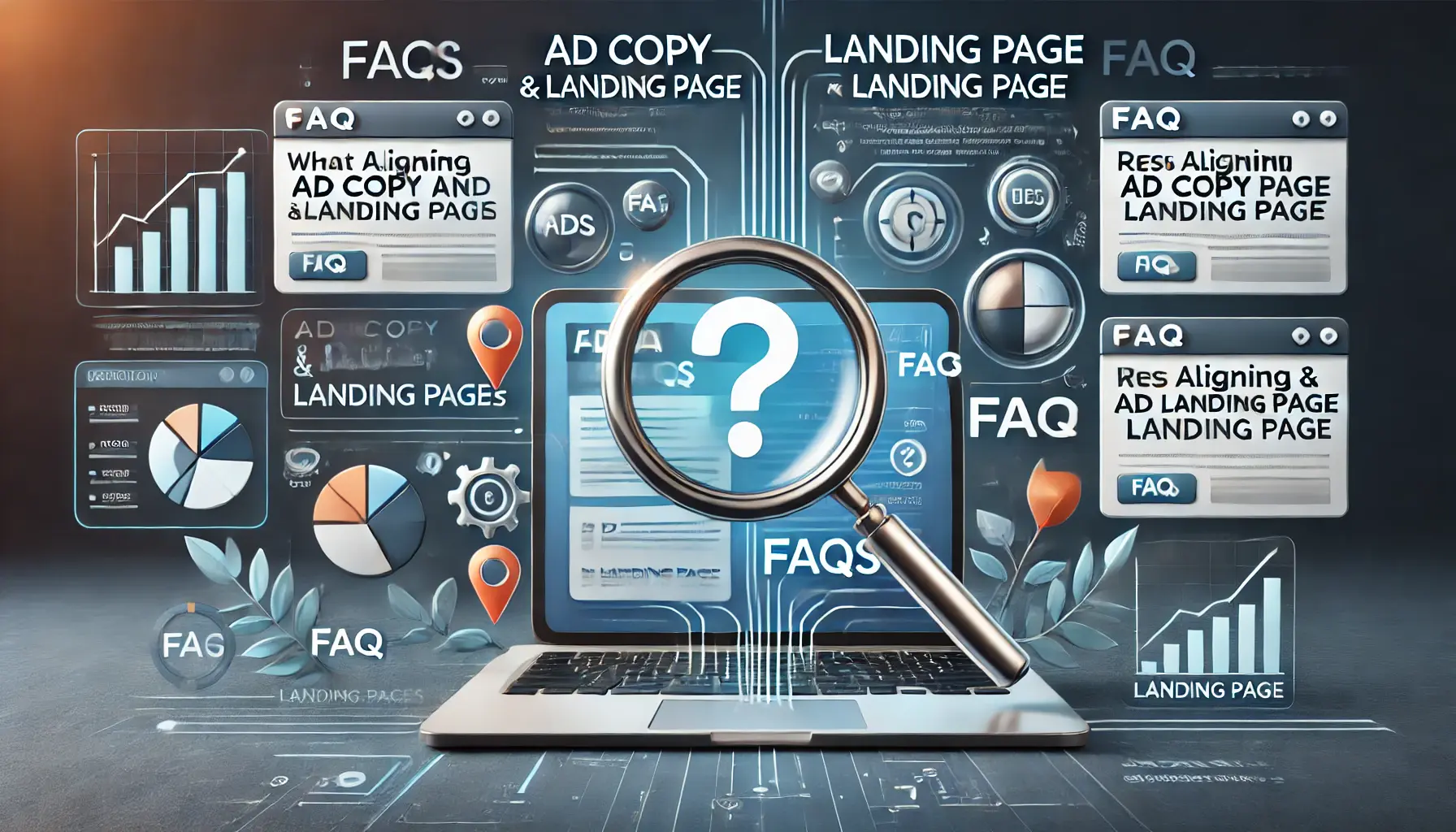
An image representing the thoughtful analysis of common questions related to aligning ad copy and landing pages.
Your campaigns can be managed by an agency specialized in Google Ads, check out our service page.
Ad Copy and Landing Page Synergy Questions
In this section, we will address some of the most commonly asked questions regarding the creation of ad copy and landing page synergy for your Google Ads campaigns.
Alignment between ad copy and landing pages is important because it provides consistency in the user’s experience.
This builds trust and keeps users engaged, driving higher conversion rates and better Google Ads performance.
Use consistent messaging, keywords, and design elements between your ad copy and landing page.
Ensure that the value proposition and tone match for a seamless user experience from click to conversion.
Keywords in your ad copy and landing page ensure alignment with user search intent.
Correct keyword usage increases Google Ads relevance scores and strengthens the connection between the ad and landing page.
Continuously A/B test and analyze user behavior to maintain optimization.
Testing every few weeks helps you identify what works best and allows for data-driven adjustments to improve performance.


